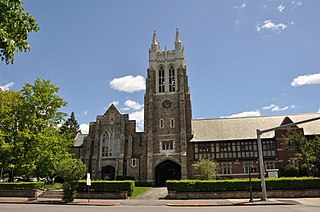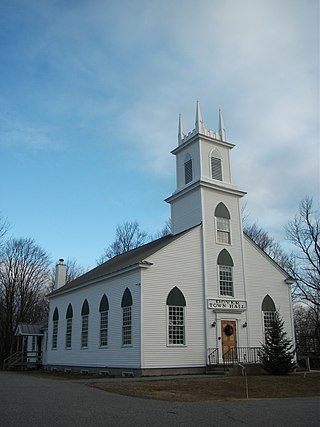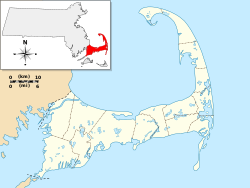
Ralph Adams Cram was a prolific and influential American architect of collegiate and ecclesiastical buildings, often in the Gothic Revival style. Cram & Ferguson and Cram, Goodhue & Ferguson are partnerships in which he worked. Cram was a fellow of the American Institute of Architects.

Provincetown Harbor is a large natural harbor located in the town of Provincetown, Massachusetts. The harbor is mostly 30 to 90 feet deep and stretches roughly 1 mile (1.6 km) from northwest to southeast and 2 miles (3.2 km) from northeast to southwest – one large, deep basin with no dredged channel necessary for boats to enter and exit.

The Pilgrim Monument in Provincetown, Massachusetts, was built between 1907 and 1910 to commemorate the first landfall of the Pilgrims in 1620 and the signing of the Mayflower Compact in Provincetown Harbor. This 252-foot-7+1⁄2-inch-tall (77.0 m) campanile is the tallest all-granite structure in the United States and is part of the Provincetown Historic District.

The Center Methodist Church or Center Methodist Episcopal Church is located in Provincetown, Massachusetts at 356 Commercial Street. It is listed on the National Register of Historic Places. The church moved to a new building in 1955, and the building has changed hands several times since. It is currently the home of the Provincetown Public Library.

The Old Provincetown Public Library building is a historic building at 330 Commercial Street in downtown Provincetown, Massachusetts. Built in 1874, it served as the town's public library from then until 2002, when the library was moved to the former Center Methodist Church. The building, a fine local example of Second Empire architecture, now houses the local tourist board. It was listed on the National Register of Historic Places in 1975.

The First Unitarian Universalist Society in Newton occupies a prominent location at 1326 Washington Street in the heart of the village of West Newton in Newton, Massachusetts. Architect Ralph Adams Cram designed the church, Frederick Law Olmsted Jr. designed the grounds, the cornerstone was laid in 1905, and it was dedicated in 1906; it is one of the village's oldest buildings. The church is in Cram's signature Gothic Revival style, with buttressed walls and a blocky square tower with crenellations and spires. An enclosed courtyard is formed by an office wing, banquet hall, and parish house, which are built to resemble Elizabethan architecture with brick first floor and half-timbered upper level.

The Unitarian Universalist Meeting House of Provincetown is an historic church at 236 Commercial Street in Provincetown, Massachusetts. The Greek Revival building was built in 1847 based on a design by Benjamin Hallett, for a congregation that had been established in 1829. It is a massive post and beam timber-frame construction, and was originally built without the tower. The tower, which is telescopic in form, with Greek ornamentation, is the only surviving steeple in Provincetown, and is a landmark for seafarers.

The First Unitarian Church is a historic church and congregation at 12 West Franklin Street in Mount Vernon, Baltimore, Maryland. Dedicated in 1818, it was the first building erected for Unitarians in the United States. The church is a domed cube with a stucco exterior. The church, originally called the "First Independent Church of Baltimore", is the oldest building continuously used by a Unitarian congregation. The name was changed in 1935 to "The First Unitarian Church of Baltimore " following the merger with the former Second Universalist Church at East Lanvale Street and Guilford Avenue in midtown Baltimore. The American Unitarian Association and the Universalist Church of America (established 1866) representing the two strains of Unitarian Universalism beliefs and philosophies merged as a national denomination named the Unitarian Universalist Association in May 1961.

The First Universalist Church is a historic Universalist Church building at 125 Highland Avenue in Somerville, Massachusetts. The Romanesque church building was built between 1916 and 1923 to a design by Ralph Adams Cram, and is the only example of his work in Somerville. The building was listed on the National Register of Historic Places in 1989. It is currently owned by the Highland Masonic Building Association, and is the home of King Solomon's Lodge AF & AM, the builders of the Bunker Hill Monument.

The Unitarian Universalist Church of Medford and The Osgood House are a historic Unitarian Universalist church building and parsonage house at 141 and 147 High Street in Medford, Massachusetts.

The Common District encompasses the main civic center of Wakefield, Massachusetts. It is centered on the historic town common, just south of Lake Quannapowitt, which was laid in 1644, when it became the heart of Old Reading. The area was separated from Reading as South Reading in 1818, and renamed Wakefield in 1868. The 25 acre district includes the buildings that line the common on Common Street and Main Street, which include the town hall, public library, YMCA, post office, and several churches. It was listed on the National Register of Historic Places in 1990.

First Parish Church in Plymouth is a historic Unitarian Universalist church at the base of Burial Hill on the town square off Leyden Street in Plymouth, Massachusetts. The congregation was founded in 1620 by the Pilgrims in Plymouth. The current building was constructed in 1899.

Stephen Carpenter Earle was an architect who designed a number of buildings in Massachusetts and Connecticut that were built in the late 19th century, with many in Worcester, Massachusetts. He trained in the office of Calvert Vaux in New York City. He worked for a time in partnership with James E. Fuller, under the firm "Earle & Fuller". In 1891, he formed a partnership with Vermont architect Clellan W. Fisher under the name "Earle & Fisher".

The Unitarian Universalist Church is a historic church building at 100 N. State Street in Ann Arbor, Michigan. It was listed on the National Register of Historic Places in 1978.

The Bradford Community Church, originally the Henry M. Simmons Memorial Church and later the Boys and Girls Library, is a historic church built in 1907 in Kenosha, Wisconsin, United States under the leadership of Kenosha's first woman pastor.

The Housatonic Congregational Church is a historic church building at 1089 Main Street in Great Barrington, Massachusetts. Built in 1892 it is a prominent local example of Queen Anne Revival architecture, and was listed on the National Register of Historic Places in 2002. It is now home to the Unitarian Universalist Meeting of South Berkshire.

Dover Town Hall is located in the village center of Dover, Vermont, at the junction of Holland and Taft Brook Roads. Built in 1828, it is a well-preserved example of a transitional Federal-Gothic Revival church building, converted to government use in 1875. It was listed on the National Register of Historic Places in 1988.

Built in 1816, the Unitarian Universalist Meeting House is the oldest remaining place of worship established by settlers in Burlington, Vermont. It is located along the northern side of the intersection of Pearl Street and the Church Street Marketplace.

First Unitarian Church is a historic building located in the downtown area of Iowa City, Iowa, United States. The local Universalist congregation traces its beginnings to 1841. Their building at Iowa Avenue and Dubuque Street was destroyed in a fire in 1868, and they built a larger building at Iowa Avenue and Clinton Street. In 1881 the Universalists merged with the local Unitarian Society. In their arrangement, the Unitarians paid for the minister while the Universalists owned the church building. The University of Iowa bought their building in 1907 and renamed it Unity Hall for use as a student union. The Unitarian-Universalist congregation dedicated this Tudor Revival building for their use on October 24, 1908. The dedication address was given by Rev. Eleanor E. Gordon, who was the secretary of the State Unitarian Conference of Iowa at the time. Because of their growth and costs to update the old building, the congregation voted in 2015 to build a new structure in near-by Coralville. They sold this building to developer Jesse Allen. It has subsequently been used as a winter shelter for the homeless while plans were made to include it in a new commercial-residential development. The former church building was listed on the National Register of Historic Places in 2018.

Theodore Parker Unitarian Universalist Church is a historic church building at 1859 Centre Street in the West Roxbury neighborhood of Boston, Massachusetts. Built in 1900 to a design by West Roxbury native Henry M. Seaver, it is a locally significant example of Normanesque architecture, and is adorned by stained glass windows created by Louis Comfort Tiffany and his firm. The church was listed on the National Register of Historic Places in 2020. The congregation it houses was founded in 1712, and is named for the influential Transcendentalist and abolitionist Theodore Parker, who was the congregation's minister in the 1840s.
































